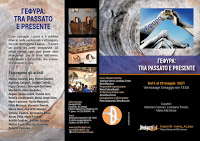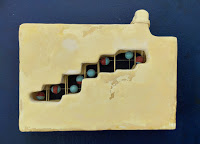
Video "ΓΕΦΥΡΑ:BETWEEN THE PAST AND THE PRESENT"
Video "GALLERIA Il RIVELLINO"
"ΓΕΦΥΡΑ:BETWEEN THE PAST AND THE PRESENT" Francais Italiano
Contemporary art exhibition From 5 to 30 May 2021 Palazzo dei Rolli Saluzzo 7/2, 16123 GENOVA
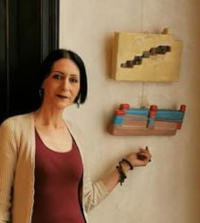
"QUAY OF THE RIVER SEINE" by NATALIA JACQUOUNAIN

"The vase gives shape to the void, music to silence"
(G. Braques)
"Quay of the river Seine" is the form that Natalia Jacquounain, a Russian artist, expressed to give fullness to the void, mentioned by Braques.
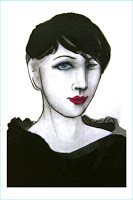
In the work, the author also collects the
the meaning of music, "so that the same form annihilates the silence ".
The syntagm "void/form/music" evolves then into "appearance": the concepts become in fact more and more complex.
In fact, the concepts are thus divided to appear before us as an architectural expression.
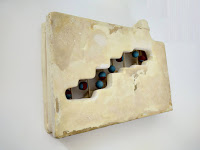
The term architect comes from the Greek ἀρχιτέκτων
and is composed of the term ἀρχή (related to ἀρχειν - árchein- to begin, to command, which expresses in ancient Greek the meaning of enterprise,
of departure, origin, foundation or orientation) and of the term τέκτων (to invent, create, shape).
Aristotle distinguishes at least six meanings of the term, attributable to the two main meanings of ἀρχή, i.e. first in importance
or first in order of time. When primacy of value and temporal primacy coincide, ἀρχή expresses divinity:
God as the highest value and first cause of all things.
According to Herodotus, the architect is the one who provides the standard for the construction of anything.
Natalia Jacquounain builds this something, understood as an identity that holds an ineffable part: "Quai de la Seine"
preserves, indeed, the intimate sound released by the breaking of the waves of the French river on the shore.
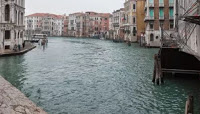
The aesthete diffuses this fragrant and musical condition
and musical condition in the delicacy of the ceramic, which transforms into a sculptural aedo to declaim the poetic song.
The author manifests the essence of the architecture of water by concretising it in the sculptural act: from the natural condition expressed by the embrace of the undulating waves of the Seine with the quay, the author shapes the genesis of the musical word.
expressed by the embrace of the undulating waves of the Seine with the quay, the author shapes the genesis of the musical word.
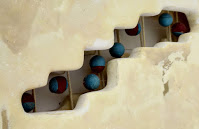
The composition highlights a threshold
which represents the musical scale and also the existential ups and downs; it introduces a penetration where the artist
sanctifies an earthly melisma.
It entrusts the lines of an imaginative pentagram with spherical notes, which are clothed with an important symbolic connotation.

Borges deposited in the Aleph the meaning
of the inconceivable universe, never embraced by any man.
(...) I closed my eyes and opened them again. Then I saw the aleph...
In the short story "The Last Einstein-Rosen Bridge" by Rudy Rucker, a child finds a glowing sphere in an asparagus field:
It is an "Einstein-Rosen bridge" (i.e. an object, theorised by Einstein in an article written in collaboration with Nathan Rosen in 1935,
which expresses the existence of a bridge).
Rosen in 1935, which expresses the possibility of communication "tunnels" between two different universes). For the child, it is as if
To the child, it is as if a whole universe of infinite dimensions is contained in this ball of finite dimensions.
This idea of an infinite world in a finite space is also expressed by M.C. Escher in more than one of his works.
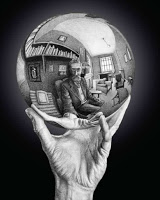
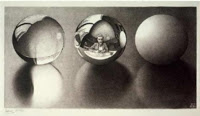
Giulio Carlo Argan wrote about
Lucio Fontana as follows:
"A painting is always a coloured surface, its ideal form is the plane; a sculpture is always a plastic volume
its ideal form is the sphere.
As a sculptor, Fontana destroys sculpture: he models large spheres and breaks them.
It is a gesture: but the gesture that breaks the sphere puts the outer space in communication with the inner. "
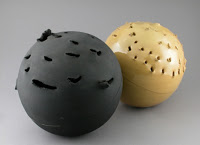
A complicit thought is found in in the sculptures of A. Pomodoro.....
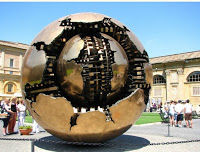
And how better to conclude on the 'exploration' of the sphere than with the surrealist and mysterious painting of René Magritte: the mystery which, as Magritte himself pointed out, is a tool for destroying visual habits and the logic of clichés!"
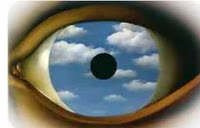
The notes molded by Natalia Jacquounain
vibrate on suprasensible experiential chords and release an eloquence that speaks to us of ascending and transverse movements
and transversal movements, of competent evolution towards a unique becoming and also towards unknown destinations. They float animated
by the movements of the passion and the desire to go towards the next day, prevailing by the red and blue tints, with which the artist distinguishes the
the artist distinguishes the nuclei.
They also keep a charming and nostalgic past, that I want to express with the verses of Gerhard Kofler:
"From the Seine Ungaretti makes me reborn as a young poet.
but Celan renews for me the gesture of water in the flight of death
the open doors the closed doors
in the rooms of the river
I listen to the rhythms
Proust enters through the window
of all the open books I live, I seek myself."
This reserves the particular artist for the context of the Geneva collective "ΓΕΦΥΡΑ:BETWEEN THE PAST AND THE PRESENT". :
